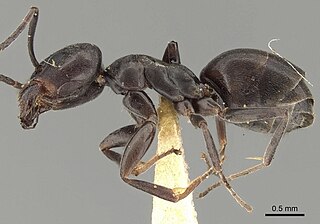
The erratic ant is a species of dolichoderine ant first described in 1789 by Latreille.

Tapinoma is a genus of ants that belongs to the subfamily Dolichoderinae. The genus currently comprises 74 described species distributed worldwide in tropical and temperate regions. Members of are generalized foragers, nesting in a wide variety of habitats, ranging from grasslands, open fields, woodlands, to inside buildings. The majority of species nest in the ground under objects such as stones or tree logs, other species build nests under bark of logs and stumps, in plant cavities, insect galls or refuse piles.
Tapinoma aberrans is a species of ant in the genus Tapinoma. Described by Santschi in 1911, the species is endemic to Madagascar.
Tapinoma minutissimum is an extinct Oligocene species of ant in the genus Tapinoma. Described by Emery in 1891, specimens of the species were found in Sicilian amber, whence a fossilised male of the species was described.
Tapinoma electrinum is an extinct species of ant in the genus Tapinoma. Described by Dlussky in 2002, fossils of the species were found in the Rovno amber in Ukraine, where a fossilised male of the species was described.
Tapinoma baculum is an extinct species of ant in the genus Tapinoma. Described by Zhang in 1989, fossils of the species were found in China.
Tapinoma glaesaria is an extinct species of ant in the genus Tapinoma. Originally described by Gennady Dlussky in 2002 as Tapinoma aberrans, fossils of the species were found in the Rovno amber in Ukraine. The original specific name was a secondary homonym of Tapinoma aberrans, an extant species from Madagascar. Perrichot, Salas-Gismondi & Antoine (2019) coined a replacement name T. glaesaria for the taxon described by Dlussky.
Tapinoma amazone is a species of ant in the genus Tapinoma. Described by William Morton Wheeler in 1934, the species is endemic to Brazil.

Tapinoma annandalei is a species of ant in the genus Tapinoma. Described by William Morton Wheeler in 1928, the species is endemic to India.
Tapinoma arnoldi is a species of ant in the genus Tapinoma. Described by Forel in 1913, the species is endemic to Zimbabwe.
Tapinoma chiaromontei is a species of ant in the genus Tapinoma. Described by Menozzi in 1930, the species is endemic to Somalia.
Tapinoma indicum is a species of ant in the genus Tapinoma. Described by Forel in 1895, the species is endemic to various countries in Asia.

Tapinoma israele is a species of ant in the genus Tapinoma. Described by Forel in 1904, the species is endemic to Algeria and Israel. Tapinoma israele is one of the fewest species that build Solaria during the winter.

Tapinoma nigerrimum is a species of ant in the genus Tapinoma. Described by Nylander in 1856, the species is endemic to Africa and Europe.
Tapinoma rasenum is a species of ant in the genus Tapinoma. Described by Smith and Lavigne in 1973, the species is endemic to Puerto Rico.
Tapinoma schreiberi is a species of ant in the genus Tapinoma. Described by Hamm in 2010, the species is endemic to the United States.
Tapinoma subboreale is a species of ant in the genus Tapinoma. Described by Seifert in 2012, the species is endemic to Europe.

Tapinoma wilsoni is a species of ant in the genus Tapinoma. Described by Sharaf and Aldawood in 2012, the species is endemic to Saudi Arabia.
Tapinoma wroughtonii is a species of ant in the genus Tapinoma. Described by Forel in 1904, the species is endemic to Italy, North Korea and South Korea.

An ant supercolony is an exceptionally large ant colony, consisting of a high number of spatially separated but socially connected nests of a single ant species, spread over a large area without territorial borders. Supercolonies are typically polygynous, containing many egg-laying females. Workers and queens from different nests within the same supercolony can freely move among the nests, and all workers cooperate indiscriminately with each other in collecting food and care of the brood, and show no apparent mutual aggressive behavior.






